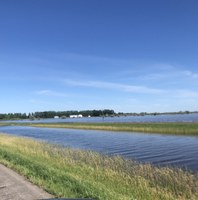NDSU Extension Offers Guidance Amidst Power Outages and Flooding
(Click the image below to view a high-resolution image that can be downloaded)
As snowstorms, power outages and flooding impact much of the state, North Dakota State University Extension offers guidance to help North Dakotans stay safe and take steps to prevent further disasters.
Stand-by Generators
With widespread power outages, many people are relying on stand-by generators. NDSU Extension agricultural engineer Ken Hellevang reminds people that generators should remain outdoors.
“Carbon Monoxide poisoning is common after disasters due to the generator being in a building, even with the door open,” says Hellevang. “Do not connect the generator to a home or farm electrical system without a transfer switch that disconnects the farm or home from the power line and connects to the generator. The wiring system must be isolated from the power lines using a double-throw transfer switch to prevent the generator from feeding electricity back into the power line.”
Additionally, Hellevang advises people to ensure that the generator matches the electrical load and only supplies power to the desired circuits.
“As a guide, electric motors require approximately 4,000 watts of power to start and 1,000 watts of power to run for every horsepower of output,” says Hellevang. “A typical home operating a water pump, refrigerator, freezer, furnace blower (gas furnace) and a few lights will require about 5,000 watts of peak usage for starting and 2,000 watts for continuous operation. Sum the wattage of each light, refrigerator motor and furnace blower to determine what the generator can power.”
“If using extension cords, assure that the wire is the appropriate size for the wattage,” says Hellevang. “A motor will ‘burn-out’ if the wire is too small or a long cord is used due to voltage loss in long cords or wires.”
Flooding
Hellevang also offers guidance for those dealing with spring flooding.
“Flooding can cause washouts and severe erosion,” says Hellevang. “Be very careful in navigating during and after flooding.”
Hellevang advises farmers and ranchers take several key steps during and after flooding.
- Examine farm buildings for any movement from alignment.
- Test the water of any wells that have been flooded before using.
- Check grain bins for any stretching of bolt holes if the grain got wet.
- Watch for signs of flood-related diseases in livestock, such as lameness, fever, difficulty breathing, muscle contractions or swelling of the shoulders, chest, back, neck or throat.
Basement seepage is another common problem with saturated soil and flooding.
“Remove wet porous materials or dry completely within a couple days to limit mold growth,” says Hellevang. “Most carpets require airflow on both sides to adequately dry.”
Hellevang adds that a ground-fault circuit interrupter must be used with all electrical use in a wet environment to prevent electrocution.
“Finally, contact your insurance agent and document all damage,” says Hellevang.
Additional information on flood recovery is available by searching online for “NDSU Extension Disasters” or contacting your local NDSU Extension county office.
NDSU Agriculture Communication – April 28, 2022
Source: Ken Hellevang, 701-231-7243, kenneth.hellevang@ndsu.edu
Editor: Elizabeth Cronin, 701-231-5391, elizabeth.cronin@ndsu.edu


